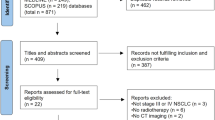Abstract
Purpose
We retrospectively compared the survival rate in patients with non-small-cell lung cancer (NSCLC) treated with radiofrequency ablation (RFA), surgery, or chemotherapy according to lung cancer staging.
Materials and Methods
From 2000 to 2004, 77 NSCLC patients, all of whom had WHO performance status 0–2 and were >60 years old, were enrolled in a cancer registry and retrospectively evaluated. RFA was performed on patients who had medical contraindications to surgery/unsuitability for surgery, such as advanced lung cancer or refusal of surgery. In the RFA group, 40 patients with inoperable NSCLC underwent RFA under computed tomography (CT) guidance. These included 16 patients with stage I to II cancer and 24 patients with stage III to IV cancer who underwent RFA in an adjuvant setting. In the comparison group (n = 37), 13 patients with stage I to II cancer underwent surgery; 18 patients with stage III to IV cancer underwent chemotherapy; and 6 patients with stage III to IV cancer were not actively treated. The survival curves for RFA, surgery, and chemotherapy in these patients were calculated using Kaplan–Meier method.
Results
Median survival times for patients treated with (1) surgery alone and (2) RFA alone for stage I to II lung cancer were 33.8 and 28.2 months, respectively (P = 0.426). Median survival times for patients treated with (1) chemotherapy alone and (2) RFA with chemotherapy for stage III to IV cancer were 29 and 42 months, respectively (P = 0.03).
Conclusion
RFA can be used as an alternative treatment to surgery for older NSCLC patients with stage I to II inoperable cancer and can play a role as adjuvant therapy with chemotherapy for patients with stage III to IV lung cancer.


Similar content being viewed by others
References
Gillams A (2009) Tumor ablation: current role in the liver, kidney, lung and bone. Cancer Imaging 2(9):68–70
Rose SC (2008) Radiofrequency ablation of pulmonary malignancies. Semin Respir Crit Care Med 29(4):361–383
Hiraki T, Gobara H, Mimura H et al (2008) Percuteneous radiofrequency ablation of lung cancer. Lancet Oncol 97(7):604–605
Jin GY, Lee JM, Lee YC et al (2004) Primary and secondary lung malignancies treated with percutaneous radiofrequency ablation: evaluation with follow-up helical CT. AJR Am J Roentgenol 183(4):1013–1020
Nguyen CL, Scott WJ, Young NA et al (2005) Radiofrequency ablation of primary lung cancer: results from an ablate and resect pilot study. Chest 128(5):3507–3511
Jin GY, Han YM, Lee YS et al (2008) Radiofrequency ablation using a monopolar wet electrode for the treatment of inoperable non-small cell lung cancer: a preliminary report. Korean J Radiol 9(2):140–147
VanSonnenberg E, Shankar S, Morrison PR et al (2005) Radiofrequency ablation of thoracic lesions. Part 2. Initial clinical experience—technical and multidisciplinary considerations in 30 patients. AJR Am J Roentgenol 184(2):381–390
Steinke K, King J, Glenn D et al (2004) Percutaneous imaging-guided radiofrequency ablation in patients with colorectal pulmonary metastases: 1-year follow-up. Ann Surg Oncol 11(2):207–212
Lee JM, Jin GY, Goldberg SN et al (2004) Percutaneous radiofrequency ablation for inoperable non-small cell lung cancer and metastases: preliminary report. Radiology 230(1):125–134
Dupuy DE, Mayo-Smith WW, Abbott GF, DiPetrillo T (2002) Clinical application of radio-frequency tumor ablation in the thorax. Radiographics 22:S259–S269
Gandhi NS, Dupuy DE (2005) Image-guided radiofrequency ablation as a new treatment option for patients with lung cancer. Semin Roentgenol 40(2):171–181
Jain SK, Dupuy DE, Cardarelli GA et al (2003) Percutaneous radiofrequency ablation of pulmonary malignancies: combined treatment with brachytherapy. AJR Am J Roentgenol 181(3):711–715
Kelekis AD, Thanos L, Mylona S et al (2006) Percutaneous radiofrequency ablation of lung tumors with expandable needle electrodes: current status. Eur Radiol 16(11):2471–2482
Steinke K, Sewell PE, Dupuy D et al (2004) Pulmonary radiofrequency ablation―an international study survey. Anticancer Res 24(1):339–343
Lencioni R, Crocetti L, Cioni R et al (2008) Response to radiofrequency ablation of pulmonary tumors: a prospective, intention-to-treat, multicentre clinical trial (the RAPTURE study). Lancet Oncol 9(7):631–638
Goldberg SN, Grassi CJ, Cardella JF et al (2005) Image-guided tumor ablation: standardization of terminology and reporting criteria. Radiology 235(3):728–739
Stinchcombe TE, Choi J, Schell MJ et al (2006) Carboplatin-based chemotherapy in patients with advanced non-small cell lung cancer and a poor performance status. Lung Cancer 51(2):237–243
Robert F, Blumenschein G, Herbst RS et al (2005) Phase I/IIa study of cetuximab with gemcitabine plus carboplatin in patients with chemotherapy-naive advanced non-small-cell lung cancer. J Clin Oncol 20(23):9089–9096
Yan TD, King J, Sjarif A et al (2006) Percutaneous radiofrequency ablation of pulmonary metastases from colorectal carcinoma: prognostic determinants for survival. Ann Surg Oncol 13(11):1529–1537
Lencioni R, Crocetti L, Cioni R et al (2004) Radiofrequency ablation of lung malignancies: Where do we stand? Cardiovasc Intervent Radiol 27(6):581–590
El-Sherif A, Luketich JD, Landreneau RJ et al (2005) New therapeutic approaches for early stage non-small cell lung cancer. Surg Oncol 14(1):27–32
Zemlyak A, Moore WH, Bilfinger TV (2010) Comparison of survival after sublobar resections and ablative therapies for stage I non-small cell lung cancer. J Am Coll Surg 211(1):68–72
Tamiya A, Naito T, Ono A et al (2010, June 4) Evaluation of the efficacy and safety of chemotherapy for patients with wet stage IIIB/IV non-small-cell lung cancer aged 80 years old or more. Lung Cancer [Epub ahead of print]
Chua TC, Thornbury K, Saxena A et al (2010) Radiofrequency ablation as an adjunct to systemic chemotherapy for colorectal pulmonary metastases. Cancer 116(9):2106–2114
Conflict of interest
None.
Author information
Authors and Affiliations
Corresponding author
Rights and permissions
About this article
Cite this article
Lee, H., Jin, G.Y., Han, Y.M. et al. Comparison of Survival Rate in Primary Non-Small-Cell Lung Cancer Among Elderly Patients Treated With Radiofrequency Ablation, Surgery, or Chemotherapy. Cardiovasc Intervent Radiol 35, 343–350 (2012). https://doi.org/10.1007/s00270-011-0194-y
Received:
Accepted:
Published:
Issue Date:
DOI: https://doi.org/10.1007/s00270-011-0194-y




